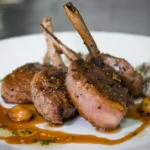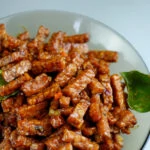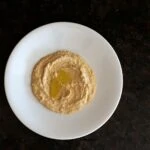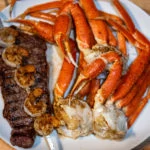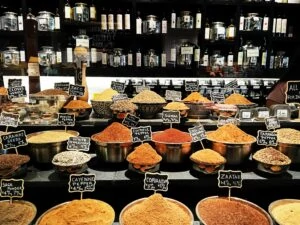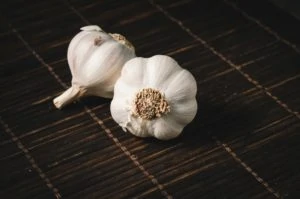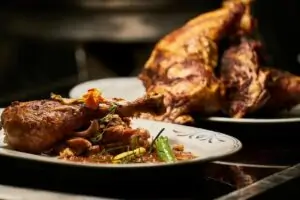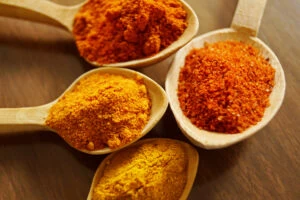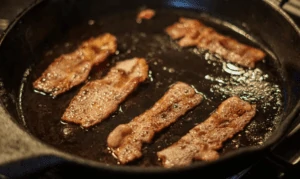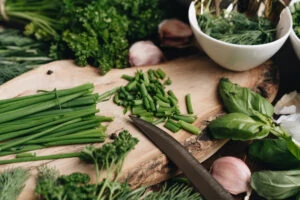Cinnamon Toast, Snicker doodle cookies, and the oh-so-delicious Cinnamon Rolls all get their signature flavor from this amazing spice.
What is Cinnamon?
Cinnamon spice comes from the inner bark of the cinnamon tree. It’s the spicy warmth found in sweet and savory Indian cuisines, as a flavoring for snacks and cereals, and as a delicious spice in many baked and holiday treats. In the United States, the term cinnamon covers both true cinnamon spice as well as its cousin, cassia. Cinnamon is sold as ground cinnamon, in splinters, in curled cinnamon sticks called quills, and as cinnamon oil.
How Is Cinnamon Made?
Cinnamon spice comes from the inner bark of the cinnamon tree, found in alpine tropical forests in Asia.
What Is Cinnamon’s History?
Both Cinnamon and cassia have a long spice history for their medicinal properties that make them valuable medicine ingredients, and for their aroma and flavor in cooking.
In ancient Egypt, cinnamon was used for its antibacterial properties in embalming ceremonies. It was also a common spice used to cook meat.
In the 17th Century, one of the most popular spice traders was the Holland East India Company, who made cinnamon available in kitchens all over the world.
Types of Cinnamon
The cinnamon you have in your kitchen is probably actually cassia, a spice in the cinnamon family that isn’t actually cinnamon. Cassia comes from the inner bark of the cassia tree, a native to China. Cassia is also known as Chinese cinnamon, or “bastard cinnamon” since it isn’t actually cinnamon at all. Cassia is a cheaper version of cinnamon that tastes stronger and has a darker color than true cinnamon.
Common true cinnamon comes in several varieties, including verum cinnamon, a variety from Sri Lanka, ceylon cinnamon or Sri Lankan cinnamon, an Indonesian cinnamon. Saigon cinnamon or vietnamese cinnamon is another form of cassia cinnamon.
What Does it Taste Like?
Cinnamon tastes intensely sweet and spicy. Cassia has a stronger flavor than the subtler, true cinnamon that has floral notes.
Ceylon cinnamon has a sweeter flavor than cassia cinnamon, and tastes more delicate. Ceylon cinnamon has a chemical compound called coumarin which gives ceylon cinnamon a light vanilla aroma and flavor. Ceylon cinnamon should be consumed in ration since it acts as a natural blood thinner.
Vietnamese cinnamon or saigon cinnamon has the traditional strong, sweet, and spicy aroma and flavor.
Where to Buy Cinnamon
Cassia is available in every grocery store in the spice isle. True cinnamon, which is typically ceylon cinnamon or verum cinnamon, is best found in your local spice shop or online.
How to Cook with Cinnamon
In the Northwest, cinnamon makes its greatest debut in Autumn. It’s a popular spice in many festive desserts and root vegetable and meat dishes. It’s also one of the main ingredients in pumpkin pie spice blend.
Cinnamon is used in many cuisines, including North American’s pumpkin pie, the United Kingdom’s classic cinnamon rolls, India’s garam masala, Vietnamese pho, Mexican chili spice, and one of our favorite rice recipe tips using cinnamon sticks.
Cinnamon Sticks
There are so many uses for cinnamon quills, or those scrolls of cinnamon bark. My favorite is a mug of hot coffee or chocolate with a cinnamon stick used as a stirrer. You could also pop one in the water with your rice for a warm undertone flavor, or simmer oatmeal with cinnamon quills. Broth flavored with a few cinnamon sticks helps to tie beef and vegetable flavors together too. You could also stab a couple of cinnamon quills into apples and bake them with brown sugar. Yum!
Ground Cinnamon
Ground cinnamon is often used in baked goods where the cinnamon powder blends well with other powdered ingredients. Ground cinnamon is used to sprinkle cinnamon rolls, and is a common spice in pies and cookies. And of course, use ground cinnamon to decorate and add a pop of flavor to a frothy coffee or hot chocolate.
Cinnamon Extract
Cinnamon extract can be used in baking. The flavor of cinnamon extract is intensely sweet like ground cinnamon, but it is not as spicy. Use cinnamon extract in a variety of cakes and cookies.
Substitutes for Cinnamon
If you’re out of cinnamon, there are several spices that can be used in its place. Any spice with the warmth, spiciness, and intense sweet flavor of cinnamon will do.
The best cinnamon substitute is allspice because it shares a similar warmth and spiciness. Since allspice is more pungent than cinnamon, use 1/3 the amount of allspice that you would otherwise use for cinnamon (ratio of 1:1/3).
Cinnamon extract makes a near-perfect replacement for ground cinnamon, but since it’s stronger, use half the amount that you otherwise would use of ground cinnamon. You can make your own cinnamon extract by soaking a few cinnamon sticks in rum for two weeks.
If you don’t have cinnamon extract or allspice, cardamom can be used as a cinnamon substitute in a 1:1 ratio. Cardamom has a much more flowery aroma than does cinnamon, so smell the spice and your other ingredients first to be sure you like what the results will be.
Pumpkin pie spice blend already contains cinnamon, so you can use it as a cinnamon replacement in equal quantities. Remember that if your recipe calls for coriander, nutmeg, allspice, or cardamom, that these spices are also included in pumpkin pie spice blend so shouldn’t be doubled up.
Cinnamon Pairings
Since cinnamon spice is used in cuisines around the world, there are many different pairings that it tastes good with. Here are a few recommendations to get you exploring:
Vanilla is one of the most common pairings. Think Old Fashioned Snickerdoodles! Other flowery, sweet foods that go well with cinnamon’s warmth and spice include apple, apricot, banana, cardamom, carrot, cherry, coconut, grapefruit, pear, watermelon, plum, strawberry, tomato, orange, and mint.
Salty or full flavors that match with cinnamon’s spiciness and warmth include peanut, lamb, beef, walnut, and root vegetables.
Some of my favorite bitters that match cinnamon’s spice and intense sweetness include clove, coffee, aniseed, and dark chocolate.
Be creative!

